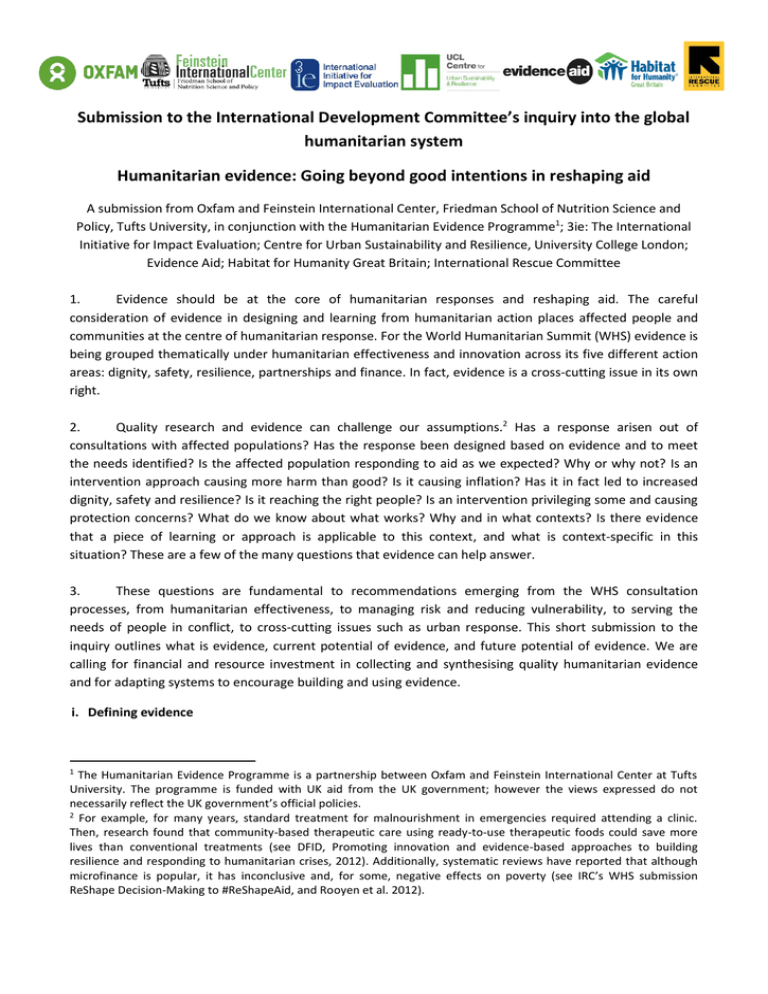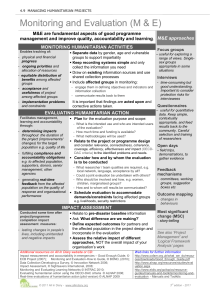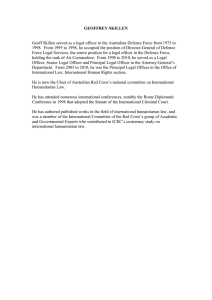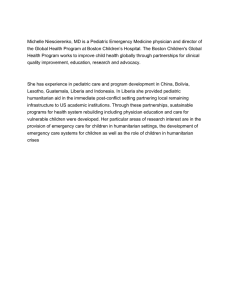Submission to the International Development Committee’s inquiry into the global
advertisement

Submission to the International Development Committee’s inquiry into the global humanitarian system Humanitarian evidence: Going beyond good intentions in reshaping aid A submission from Oxfam and Feinstein International Center, Friedman School of Nutrition Science and Policy, Tufts University, in conjunction with the Humanitarian Evidence Programme1; 3ie: The International Initiative for Impact Evaluation; Centre for Urban Sustainability and Resilience, University College London; Evidence Aid; Habitat for Humanity Great Britain; International Rescue Committee 1. Evidence should be at the core of humanitarian responses and reshaping aid. The careful consideration of evidence in designing and learning from humanitarian action places affected people and communities at the centre of humanitarian response. For the World Humanitarian Summit (WHS) evidence is being grouped thematically under humanitarian effectiveness and innovation across its five different action areas: dignity, safety, resilience, partnerships and finance. In fact, evidence is a cross-cutting issue in its own right. 2. Quality research and evidence can challenge our assumptions.2 Has a response arisen out of consultations with affected populations? Has the response been designed based on evidence and to meet the needs identified? Is the affected population responding to aid as we expected? Why or why not? Is an intervention approach causing more harm than good? Is it causing inflation? Has it in fact led to increased dignity, safety and resilience? Is it reaching the right people? Is an intervention privileging some and causing protection concerns? What do we know about what works? Why and in what contexts? Is there evidence that a piece of learning or approach is applicable to this context, and what is context-specific in this situation? These are a few of the many questions that evidence can help answer. 3. These questions are fundamental to recommendations emerging from the WHS consultation processes, from humanitarian effectiveness, to managing risk and reducing vulnerability, to serving the needs of people in conflict, to cross-cutting issues such as urban response. This short submission to the inquiry outlines what is evidence, current potential of evidence, and future potential of evidence. We are calling for financial and resource investment in collecting and synthesising quality humanitarian evidence and for adapting systems to encourage building and using evidence. i. Defining evidence 1 The Humanitarian Evidence Programme is a partnership between Oxfam and Feinstein International Center at Tufts University. The programme is funded with UK aid from the UK government; however the views expressed do not necessarily reflect the UK government’s official policies. 2 For example, for many years, standard treatment for malnourishment in emergencies required attending a clinic. Then, research found that community-based therapeutic care using ready-to-use therapeutic foods could save more lives than conventional treatments (see DFID, Promoting innovation and evidence-based approaches to building resilience and responding to humanitarian crises, 2012). Additionally, systematic reviews have reported that although microfinance is popular, it has inconclusive and, for some, negative effects on poverty (see IRC’s WHS submission ReShape Decision-Making to #ReShapeAid, and Rooyen et al. 2012). 4. Evidence in this paper is defined as information that indicates whether a belief or proposition is valid. This may be an impact evaluation showing the change caused by a programme or empirical evidence indicating whether the response was appropriate and valued by crisis-affected individuals and communities or even evidence on how a programme should get delivered. The type of evidence collected should depend on the question. Other work details the state of humanitarian evidence, such as ALNAP’s 2014 report ‘Insufficient Evidence’ and 3ie’s 2014 scoping paper ‘What evidence is available and what is required, in humanitarian assistance?’. ii. Current potential 5. The current potential of evidence can be envisioned through four processes: building and changing humanitarian programming, including direct operations, partnerships and influencing, based on evidence; synthesising existing evidence; increasing the quality of evidence; and, improving the use of evidence by humanitarian actors. 6. Building and changing humanitarian programming based on evidence. Humanitarian programming can be designed from existing needs assessments and research about the effectiveness of practices and approaches. Programming may be changed midcourse through new information, including assessments, real time evaluations, or focus groups. We join many actors who have recommended investing in the evidence base to fill in the gaps on ‘what works?’ (ALNAP Global Forum report, p. 90). This includes directly investing in new and existing research and research partnerships that build rigorous evidence in order to inform policy and practice. 7. Synthesising existing evidence. Harnessing existing data respects populations and their time by not overburdening them with data collection. Evidence synthesis is valuable for humanitarian actors who seek to understand what is known, including ‘what works’ – and what does not work – as well as for whom and in which contexts. Reviews can also synthesize what is known and not known about existing approaches, interventions, and tools. They avoid undue emphasis on any single study and allow people to consider the full evidence base when making decisions. The Humanitarian Evidence Programme has eight evidence syntheses underway, many to be completed by the World Humanitarian Summit.3 Synthesis can result in conclusions beyond those of independent studies. The IRC and 3ie have gap maps that visibly show where there are impact evaluations and syntheses on questions of what works. We encourage this analysis to help ensure that policymakers, practitioners, and funders invest in programs that work, shut down programs that cause harm, and do further research where there is not enough evidence. 8. Improving the quality of evidence. Higher quality evidence is needed to confidently challenge or confirm practices, approaches, and paradigms. Numerous documents have suggested investing in better evidence, including the IRC’s 2015 report ‘ReShape Decision-Making to #ReShapeAid’ and the 2012 report ‘Promoting innovation and evidence-based approaches to building resilience and responding to humanitarian crises: A DFID Strategy Paper.’ 3ie also has a 2014 working paper on ‘What methods may be used in impact evaluations of humanitarian assistance?’ ALNAP’s ‘Insufficient Evidence’ report judges the quality of evidence used in humanitarian action through its accuracy, representativeness, relevance, generalisability, attribution, and clarity around context and methods. Evidence should be collected and analysed by individuals and systems that are designed to be more impartial and transparent about potential 3 Current reviews focus on urban identification, child protection, shelter and settlement strategies, mental health and psychosocial support, acute malnutrition, WASH in disease outbreaks, pastoralist livelihoods, and market support. Humanitarian evidence—Page 2 conflicts of interest and risks of bias. Impact evaluations should include data for cost-effectiveness analysis. Additionally, data should be disaggregated by sex, age, and other factors to understand vulnerability and social differences. We support ensuring that research is transparent in its methodology, context, and limitations. 9. Improving the use of evidence. One of the major challenges with evidence is improving its use and critically examining what current evidence can and cannot tell us. Evidence is often disseminated and used ad-hoc. By focusing on research uptake through engaging important stakeholders, providing information in user-friendly products, building strong knowledge management systems, and shifting incentives to include the use of evidence, humanitarian actors can improve decision-making and accountability to affected populations. We recommend the humanitarian system adopt systems that incorporate and value evidence in decision-making processes. iii. Future potential 10. Given the current state of often weak evidence in the humanitarian field, humanitarian actors must be careful about how it is used. However, as the evidence base builds with more and better-quality evidence, the system can be transformed in the following ways: Impartial. Evidence can create a reflective culture of learning, so decisions are based on more than good intentions or politics, but on what quality evidence indicates. Responsive. As data collection becomes quicker and evaluation techniques improve, humanitarian aid can be more responsive to new evidence. Effective. The ultimate goal is to save lives, improve livelihoods, and maintain human dignity. Humanitarian evidence can help us better achieve by understanding what is effective in meeting the needs of affected populations. Efficient. By stopping investing in programs that cause harm or are ineffective and investing in programs that work, the aid system can improve value for money and help more people. This is of particular concern considering the increasing costs of global humanitarian responses. Efficiency must be considered carefully as ethics should be maintained, and some approaches, such as advocacy or community-based protection, may be more difficult to measure value-for-money with rigour. Accountable. Accordingly, with an aid system strengthened in these ways, it will be more accountable to crisis-affected populations. 11. In order to achieve the future of reshaped aid, we recommend that the humanitarian field invest in evidence now. It should also identify ways in which evidence-gathering and analysis can be more easily built into future practice, to provide the reliable information needed to act better in an ongoing crisis and to plan better for future ones. iv. Conclusions 12. Evidence is a fundamental building block of a vision for future humanitarian action and a crosscutting issue in reshaping aid. It adheres to core humanitarian values. In particular, the Core Humanitarian Standards state that communities and people affected by crisis can expect delivery of improved assistance as organisations learn from experience and reflection. By putting quality evidence at the centre of reshaping aid, aid can go beyond good intentions to serve crisis-affected individuals and communities. We recommend that the World Humanitarian Summit encourage humanitarian actors to invest in research and data collection, synthesis, and quality and to adapt systems to use and value evidence. Humanitarian evidence—Page 3








